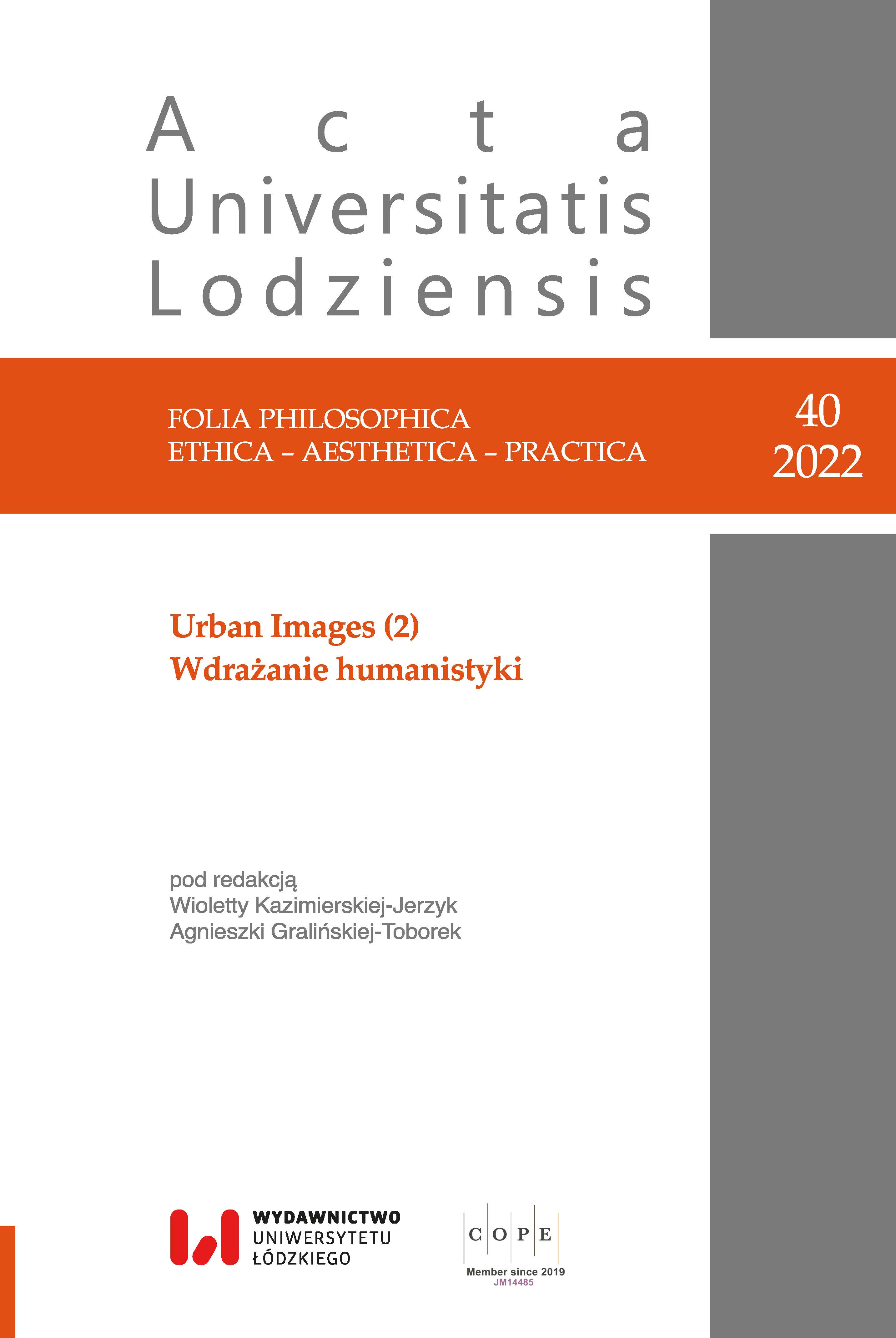Estetyczne kategorie unikatowości i osobliwości oraz ryzyko ich użycia w kontekście aksjologicznym
DOI:
https://doi.org/10.18778/0208-6107.40.06Słowa kluczowe:
unikatowość, osobliwość, kuriozalność, estetyka, semantyka, aksjologiaAbstrakt
Artykuł jest poświęcony „unikatowości” i „osobliwości” – zarówno jako terminom, które funkcjonują w ramach dyskursu teoretyczno-estetycznego, jak i wyrazom odgrywającym istotną rolę w języku potocznym. Poza kontekstem estetyki i filozoficznej refleksji nad sztuką są one powszechnie wykorzystywane przez podmioty realizujące zadania z zakresu polityki społeczno-kulturalnej do promowania wydarzeń, zjawisk i obiektów, mimo iż zarówno ich etymologia, semantyka oraz pragmatyka językowa wskazują, że są problematyczne. Mają bowiem w swoje definicje leksykalne wpisane wartościowanie, a także nabierają dodatkowej wartości oceniającej w różnych kontekstach. Ponadto, bazując na słownikowych definicjach dostrzec można, że „unikatowość” i „osobliwość” są wyrazami funkcjonującymi w rodzinie semantycznej stwarzającej istotne ryzyko zatarcia znaczeń poszczególnych słów, czego efektem jest także niejednoznaczność w estetyczno-normatywnej ocenie zjawisk opisywanych za pomocą „unikatowości” i „osobliwości”, nawet jeśli ujmowane są ściślej, jako terminy naukowe funkcjonujących w dyskursie teoretyczno-estetycznym. Analiza źródłosłowów, charakterystyka normatywnego potencjału „unikatowości” i „osobliwości” oraz wyrazów, które są im pokrewne, a także podkreślenie roli kontekstu, w jakim występują, zestawiona z podstawowym ich znaczeniem w wybranych językach nowożytnych, pozwoli uwidocznić kluczowe problemy językowe w doświadczeniu potocznym, ale również wskazać istotne z punktu widzenia zagadnień specjalistycznych różnice terminologiczne.
Bibliografia
Austin, J. L. (1993). Mówienie i poznawanie. Rozprawy i wykłady filozoficzne. Tłum. B. Chwedeńczuk. Warszawa: PWN.
Google Scholar
Bańko, M. (2000). Inny słownik języka polskiego. Warszawa: Wydawnictwo Naukowe PWN.
Google Scholar
Bańko, M. (2003). Mały słownik wyrazów kłopotliwych. Warszawa: Wydawnictwo Naukowe PWN.
Google Scholar
Bańko, M. (2007). Wielki słownik wyrazów bliskoznacznych. Warszawa: Wydawnictwo Naukowe PWN.
Google Scholar
Bańkowski, A. (2000). Etymologiczny słownik języka polskiego. Warszawa: Wydawnictwo Naukowe PWN.
Google Scholar
Boryś, W. (2005). Słownik etymologiczny języka polskiego. Kraków: Wydawnictwo Literackie.
Google Scholar
Dąbrówka, A., Geller, E. i Turczyn R. (1998). Słownik synonimów. Warszawa: Świat Książki.
Google Scholar
Dle.rea.es. Diccionario de la lengua española. Online: https://dle.rae.es/ [dostęp 4.05.2022].
Google Scholar
Długosz-Kurczabowa, K. (2003). Nowy słownik etymologiczny języka polskiego. Warszawa: Wydawnictwo Naukowe PWN.
Google Scholar
Doroszewski, W. (1958–1969). Słownik języka polskiego. Warszawa: Wiedza Powszechna / PWN.
Google Scholar
Gaver, W. W. (2007). Curious things for curious people, s. 1–8. Online: https://www.researchgate.net/publication/242534029_CURIOUS_THINGS_FOR_CURIOUS_PEOPLE [dostęp 4.05.2022].
Google Scholar
Jamrozik, E. (2005). Słownik włosko-polski, polsko-włoski. Warszawa: Wydawnictwo Naukowe PWN.
Google Scholar
Kant, I. (1986). Krytyka władzy sądzenia. Warszawa: Państwowe Wydawnictwo Naukowe.
Google Scholar
Korpanty, J. (2003). Słownik łacińsko-polski. Warszawa. Wydawnictwo Szkolne PWN.
Google Scholar
Krauss, R. E. (1997). Oryginalność awangardy. W: Nycz, R. (red.), Postmodernizm. Kraków: Wydawnictwo Baran i Suszczyński, s. 399–420.
Google Scholar
Kurzowa, Z. et al. (1998), Słownik synonimów polskich. Warszawa: Wydawnictwo Naukowe PWN.
Google Scholar
Larousse.fr. Encyclopédie et dictionnaires gratuits en ligne. Online: https://www.larousse.fr/
Google Scholar
dictionnaires/francais/p%C3%A9cuniaire/58915 [dostęp 4.05.2022].
Google Scholar
Levinson, J. (1980). Aesthetic Uniqueness. The Journal of Aesthetics and Art Criticism, 38 (4), s. 435–449.
Google Scholar
DOI: https://doi.org/10.2307/430325
Linde-Usiekniewicz, J. i Smith, P. G. (2007). Polsko-angielski słownik. Warszawa: Wydawnictwo Naukowe PWN.
Google Scholar
Mróz, J. (2021). Aesthetic Uniqueness of Public Space. Based on the Example of the Region of Łódź (Poland) Basic Terminological Issues. On the W@terfront, 63 (9), s. 3–27. https://doi.org/10.1344/waterfront2021.63.9.01 [dostęp 4.05.2022].
Google Scholar
DOI: https://doi.org/10.1344/waterfront2021.63.9.01
Onions, C. T. (1966). The Oxford Dictionary of English Etymology. Oxford: Oxford University Press.
Google Scholar
Papis, T. (2005). Słownik hiszpańsko-polski, polsko-hiszpański. Łódź: Galeria Polskiej Książki.
Google Scholar
Perlin, O. (2006). Wielki słownik polsko-hiszpański. Warszawa: Wiedza Powszechna.
Google Scholar
Plezia, M. (1998). Słownik łacińsko-polski. Warszawa: Wydawnictwo Naukowe PWN.
Google Scholar
Plezia, M. (1999). Słownik łacińsko-polski. Warszawa: Wydawnictwo Naukowe PWN.
Google Scholar
Plezia, M. (2007). Słownik łacińsko-polski. Warszawa: Wydawnictwo Naukowe PWN.
Google Scholar
Pomian, K. (1996). Zbieracze i osobliwości. Warszawa: Państwowy Instytut Wydawniczy.
Google Scholar
Robert, P. (2017). Le Petit Robert: dictionnaire alphabétique et analogique de la langue française. Paris: Le Robert.
Google Scholar
Rundell, M. (2002). Macmillan English Dictionary: For Advanced Learners. Macmillan Publishers.
Google Scholar
Sikora Penazzi, J. i Sieroszewska, K. (2015). Popularny słownik francusko-polski, polsko-francuski. Warszawa: Wiedza Powszechna.
Google Scholar
Schwarz, C. et al. (1988). Chambers English Dictionary. Cambridge: Chambers.
Google Scholar
Scruton, R. (2011). Beauty: A Very Short Introduction. Oxford: Oxford University Press.
Google Scholar
Scruton, R. (2018). Piękno. Łódź: Wydawnictwo Uniwersytetu Łódzkiego.
Google Scholar
Simmel, G. (1908), Das Problem des Stiles. Dekorative Kunst. Illustrierte Zeitschrift für Angewandte Kunst, r. 11, nr 7, t. 16, red. H. Bruckmann, s. 307–316. Online: https://socio.ch/sim/verschiedenes/1908/stil.htm [dostęp 4.05.2022].
Google Scholar
Simmel, G. (2007). Problem stylu. W: Simmel, G., Filozofia kultury wybór esejów. Kraków: Wydawnictwo Uniwersytetu Jagiellońskiego., s. 177–184.
Google Scholar
Słobodska, M. (2002). Słownik francusko-polski, polsko-francuski. Kielce: „Delta”.
Google Scholar
Summers, D. et al. (2006). Longman Dictionary. Harlow: Pearson Longman.
Google Scholar
Treccani.it. La cultura Italiana-Vocabolario-Treccani. Online: https://www.treccani.it/vocabolario/ [dostęp 4.05.2022].
Google Scholar
Wahrig-Burfeind, R. (2008). Großwörterbuch Deutsch als Fremdsprache. Warszawa: Wydawnictwo Naukowe PWN.
Google Scholar
Wierzbicka, A. (2006). Semantyka jednostki elementarne i uniwersalne. Lublin: Wydawnictwo Uniwersytetu Marii Curie-Skłodowskiej.
Google Scholar
Wiktorowicz, J. i Frączek, A. (2008). Wielki słownik polsko-niemiecki. Warszawa: Wydawnictwo Naukowe PWN.
Google Scholar
Wittgenstein, L. (1977). Wykłady o estetyce, tłum. P. Graff. Studia Estetyczne, t. XIV, s. 131–146.
Google Scholar
Wittgenstein, L. (2008). Dociekania filozoficzne. Warszawa: Wydawnictwo Naukowe PWN.
Google Scholar
Pobrania
Opublikowane
Jak cytować
Numer
Dział
Licencja

Utwór dostępny jest na licencji Creative Commons Uznanie autorstwa – Użycie niekomercyjne – Bez utworów zależnych 4.0 Międzynarodowe.












